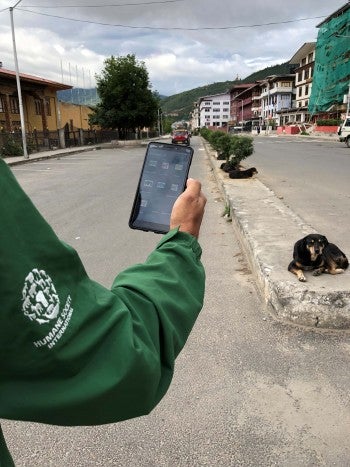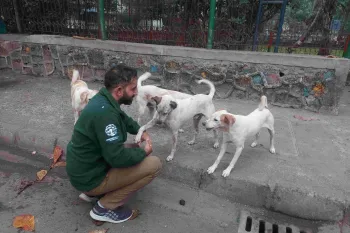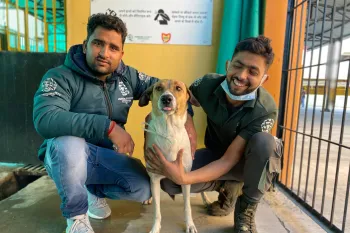Some problems facing animals seem so enormous they’re no longer even perceived as issues that can be solved—it’s just how things are. But when our India team saw so many dogs suffering on the streets, they knew things could be better. Here, Dr. Amit Chaudhari, director of Humane Society International’s Monitoring, Evaluation, Impact Assessment program, talks about how the lives of dogs living on the streets have changed thanks to data-driven action over the course of the program’s 10-year span.
Before the sun rises, members of our team jump on their motorbikes, checking their phones to make sure their batteries are charged before setting off. Each has an assigned Google map route as they set out to collect information on the street dogs they see on the road. Are they spayed and neutered? How many are adults? How many are puppies? What is the general health condition of each dog?
What began with small groups of veterinarians and animal welfare enthusiasts counting dogs in the streets of Mumbai is now a full-fledged monitoring, evaluation and impact assessment initiative of great scope and impact.
In many countries, street animals are ubiquitous, commonly seen rummaging through garbage for their next meal or finding shade under a parked car. These animals lack adequate shelter, nutritious food and veterinary care. Less obvious, though, is how their presence on the street can contribute to other problems and lead to conflict with people. Car accidents and the spread of disease can be caused or exacerbated by animals living on the streets.
HSI
Our companion animal work seeks to improve the lives of dogs and cats whether on the street or living in homes. Working with governments and communities, and focusing on providing support to the underserved, our dog and cat welfare programs in Chile, Costa Rica, Canada, Mexico, Bolivia, India, South Africa and Romania address a wide range of companion animal issues.
But the challenge is massive. While exact numbers are lacking, there are an estimated 700 million to 1 billion dogs worldwide, comprising both owned and unowned dogs living in shelters, homes or freely in urban and rural environments. Estimates suggest there are almost 362 million street cats and dogs across 20 countries.
Communities and government agencies—particularly those in countries with developing economies that often also lack basic infrastructure for humans—struggle to find affordable, humane and accessible solutions to manage dog and cat populations, promote animal welfare and foster peaceful coexistence between companion animals and people. Governments are responsible for the health and safety of their citizens, and, sadly, many still resort to killing street animals because such a “solution” is perceived as easiest and cheapest. It is not.
Finding a humane solution
Animal welfare programs are sometimes at pains to show their impact through data. Yet reliable data proving program efficacy is often needed to convince governments that nonlethal programs are worth the investment.
I began my career with HSI in 2008 as a veterinary surgeon, responding to disasters in Myanmar and India. During those early years, I had the privilege of providing surgical training to veterinarians in India, Bhutan, Bangladesh, the Philippines and Ethiopia. Working on street dog population management programs in Bhutan and India was formative for me in my thinking about how to help these animals and persuade governments that there’s a better, more humane way forward.
In 2014, I established the Monitoring, Evaluation, Impact Assessment team, initially focusing on regions in India. Our scope quickly expanded to cover Asia and we eventually became global. The MEIA team has always been dedicated to learning and developing robust methodologies for conducting various studies. This is essential, as data helps with program planning and allocating the appropriate resources.
Today, we are the only international animal welfare charity with a team dedicated to MEIA, and our objective is to ensure our programs are supported by data. We conduct street dog counts and more detailed Knowledge Attitude Practice surveys to understand public attitudes and barriers to animals receiving care. This information helps us develop effective programs that truly help animals.

Tamara Karta/HSI
Data can help policymakers make humane decisions for animals (for instance, not to cull dogs with poison or incarcerate them in shelters), so we need to have solid proof that humane interventions work. Once government leaders understand that these approaches are cost-effective, palatable to the public and in the interest of both public and animal welfare, we can generate momentum and advocate for broader policy changes for dogs, as well as cats.
For instance, in Bangladesh and Mauritius, data helped convince government officials to invest in spay/neuter programs. In both these countries, despite several challenges, spay/neuter continues to be the more humane alternative to poisoning.
Our team has built a reputation for carrying out persuasive dog population surveys that lead to positive actions and outcomes. These surveys help estimate the number of dogs on the street, which then informs what resources might be required to sterilize or vaccinate a certain percentage of them. Such surveys are done routinely in India to provide government partners and donors with timely updates on our programs.
In the city of Vadodara, a recent dog population survey found that 86.7% of street dogs were sterilized and vaccinated. This was such a successful program that team members on the ground found it increasingly difficult to locate unsterilized dogs. A good grasp of data helped the team decide when to hand the program over to the government.
Ten years of progress for street animals
Ten years ago, we embarked on a mission to bridge gaps in knowledge and understanding of the effectiveness of dog and cat welfare interventions using technology, data and population science, and by running effective, robust dog population management programs that include spay/neuter, vaccination, community engagement, education and advocacy efforts. I am proud to say that over the past decade, we have worked in more than 15 countries, authored more than 70 reports (including dog population surveys and program assessments), published peer-reviewed articles in international journals and supported HSI country teams with their program development.
We even developed a mobile-based smartphone application, HSIApps, that collects, stores and analyzes data on street dogs and cats. Recently, I traveled to Viet Nam to train government officials on using technology to improve their rabies control work.
The future is full of possibilities with the availability of new technologies, tools and everyday insights from the field. We are looking forward to integrating science with on-the-ground realities and providing support, recommendations and processes that can strengthen dog and cat welfare programs globally.
I am deeply appreciative of all that we have achieved together, and I look forward to continuing to innovate and lead in creating a more humane world for street dogs.
Dr. Amit Chaudhari is director of MEIA for Humane Society International.



